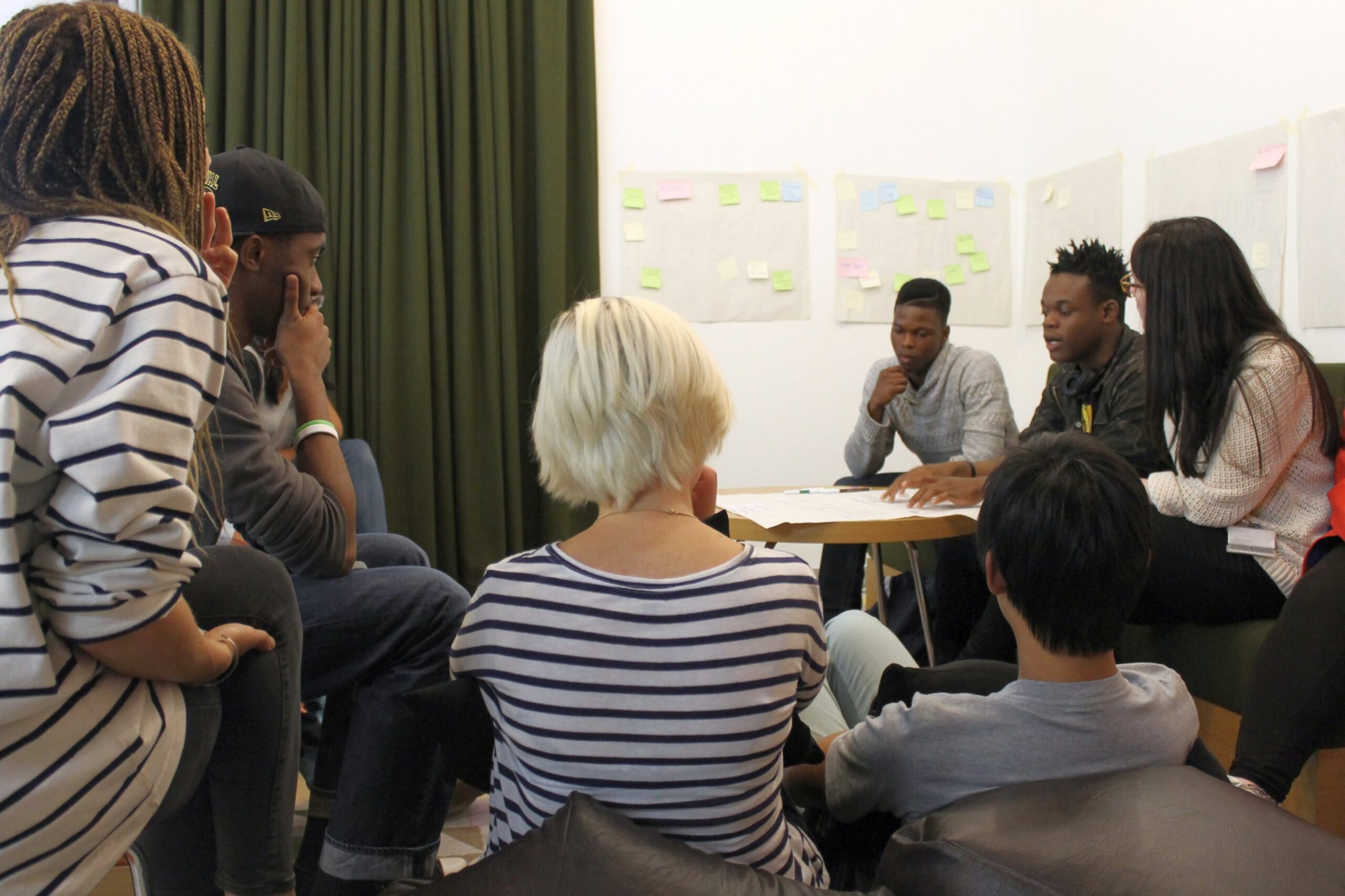
Young people taking part in a Digi Takeover session
Photo: Leyla Tahir
Creative learning opportunities
Through Tate's Circuit programme, galleries across the country are illuminating the voices of young people and delivering significant cognitive, social and emotional benefits, says Mark Miller.
Circuit is a four-year national programme that connects 15 to 25 year olds to the arts in galleries and museums. Led by Tate and funded by the Paul Hamlyn Foundation, it provides creative learning opportunities for young people across art disciplines. It began in 2013 and involves Tate Modern, Tate Britain, Tate Liverpool and Tate St Ives with partners from the Plus Tate network (Firstsite in Colchester, MOSTYN in Llandudno, Nottingham Contemporary, Whitworth Art Gallery in Manchester, and Wysing Arts Centre and Kettle’s Yard in Cambridgeshire). These galleries set the dynamic characteristic of the programme in the representation of a diverse mix of young people from rural, urban and suburban locations. Each site presents its particular approach to practice, programme content and diversity, defined by its infrastructure and location.
Large-scale festivals… have had a positive impact due to scale, visibility of young people’s work and demonstrating what young people can achieve
Built on Tate Learning’s long-term work with young people, often in vulnerable situations, we aim to increase cultural access and improve attitudes towards young people while building sustainable partnerships between the arts and youth sector, with the ambition to influence practice within and across partner organisations. Activities are delivered through four strands:
- Festival: Large-scale events;
- Peer-led: Young people producing and leading activity;
- Partnerships: Work with the youth sector and young people with the least access;
- Digital: Content produced for the website, which offers a variety of entry points for participants at differing levels of support and progression.
These strands are set up to interconnect and change traditional notions of outreach project participants, moving young people from the periphery to the core of institutions as autonomous producers of cultural activity. This has richly manifested itself in a wide range of events from the selection of artists – from performance to glitch artists – to film, pop-up shops, residencies and dance. And also from ephemeral objects that symbolise and resonate with young people’s cultural experiences, to a wealth of digital social media platforms and blogs.
As well as small to medium-scale events such as COLLABOR-8 at Nottingham Contemporary, Comicol at firstsite, Young@Tate at Tate St Ives, the programme has seen four displays, several in prime gallery locations, such as Tate Britain BP Spotlight Source, Tate Liverpool, Welcome to My World and Blueprint Exhibition, Mostyn Gallery 1 and Kettle’s Yard Grace and Speed. These were all curated by young people working in collaboration with curatorial teams, artists and with strong directorial support to continue work in this vein.
Large-scale festivals – Hyperlink at Tate Modern and Blueprint Festival at Tate Liverpool – have had a positive impact due to scale, visibility of the young people’s work and demonstrating what young people can achieve. Two major festivals are planned for this autumn by Wysing Art Centre, Kettle’s Yard and Nottingham Contemporary, and young people are also contributing to the wider objectives of galleries through their governance structures.
Evaluation is central to our work and a framework was devised to guide approaches to reflection, evidence-gathering and capturing experiences. The young people were also active evaluators in a group called Circulate. We work with evaluation, marketing and communication consultants who have contributed by providing specialist skills and knowledge exchange, criticality and support for specific areas of the programme, such as audience strategies.
More drastic cuts are set to be made to youth services and in many cities, including Manchester, Liverpool and Colchester, local council and youth service provision has shifted from resource provider to commissioners of youth services. Our partners have developed distinct site-specific motivations for accomplishing work with young people with the least access to cultural resources, and the emerging youth sector partnerships have helped to develop the programme and define what diversity means at each gallery.
The voice of young people has been illuminated through Circulate as well as the core groups who actively and collectively develop and deliver programmes with their peers. The evaluators are beginning to highlight our achievements, including a significant impact upon cognitive, social and emotional benefits. What has been found is the significant and repeated acknowledgement of the importance of the ‘social’ to young people – whether as spaces, interconnectivity and entry points via digital media, marketing opportunities and events programming, or as an intentional method to engage young people. This also brings focus to the wider social and political responsibilities and the role galleries can, or should, contribute to society today, to which young people have a huge contribution to make.
Mark Miller is Circuit’s National Lead and Convenor at Tate Modern and Tate Britain.
circuit.tate.org.uk
Tw @CircuitPHF
Join the Discussion
You must be logged in to post a comment.